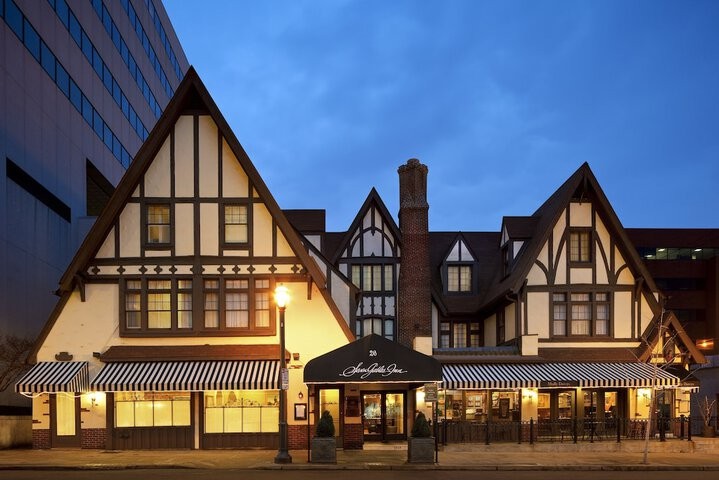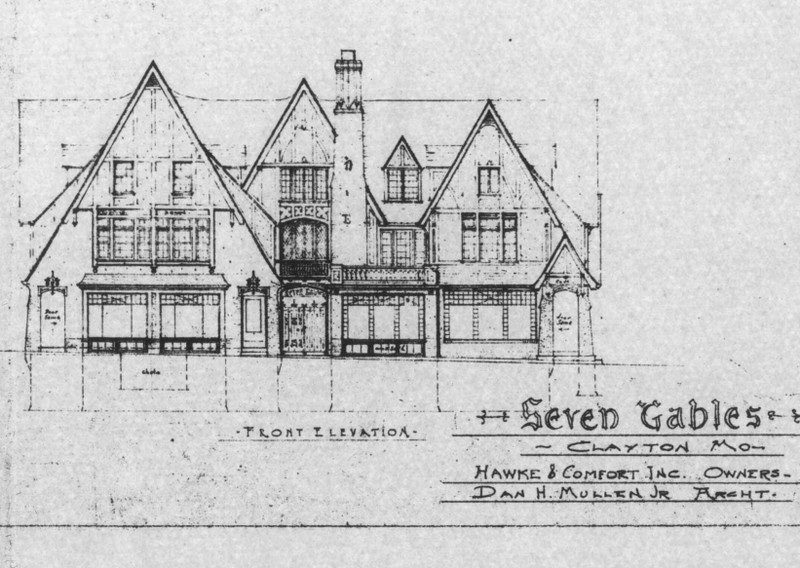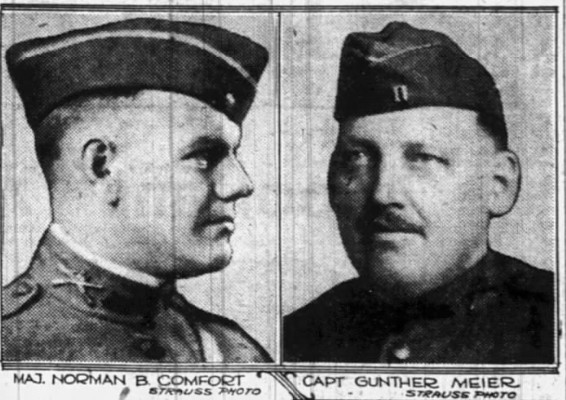Seven Gables Building
Introduction
Text-to-speech Audio
This building located in Clayton, St. Louis County was constructed in 1926 in the Tudor revival architectural style. Revivalist architecture grew in popularity as people became inspired by historical architectural design. The Seven Gables Building in particular was based on styles from England’s Tudor period (1500-1559) and later Medieval periods such as the Jacobethan and Elizabethan eras. The Tudor style is sometimes called “stockbroker Tudor'' because it is indicative of one’s financial success. It is characterized by “half-timbering [...], stucco or masonry veneered walls, and cross-gabled plans.” It was developed by the architectural firm Meier and Comfort, Inc. (previously Hawke and Comfort, Inc.) and designed by their partner, architect Daniel H. Mullen.
Images
Seven Gables Inn

Seven Gables Building sketch

Major Norman B. Comfort and Captain Gunther Meier

Backstory and Context
Text-to-speech Audio
The Seven Gables Building is unique for its Tudor style, which wasn’t commonly used in commercial buildings in Missouri despite its popularity elsewhere in the country. It is also one of the few remaining commercial buildings from its period in Clayton, and reflects the rapid development that occurred after it was incorporated as a city in 1913. Clayton’s history began in 1876 when the City of St. Louis split from St. Louis County, leaving County Courts with no courthouse. Ralph Clayton, who was born in 1788 in Virginia and was a farmer, came to Missouri in the 1830’s and settled in south east (future) Clayton. He convinced county officials that this was a good location for the courthouse because it was a “half day’s ride from the city.” He agreed to donate this site for the courthouse as long as the surrounding area was named after him. Another Virginia farmer, Martin Hanley, who arrived in Missouri in 1834 and became a Blacksmith and a merchant also donated a small plot of his land that was east of Clayton’s land. In total, they donated 104 acres which now makes up the City’s Central Business District.
At the turn of the century, Clayton garnered some attention as those who attended the St. Louis World’s Fair realized it would be a good place to settle away from the city. In 1905, prominent St. Louisan W.L. Hemingway purchased a home there. He was the president of the Mercantile and Trust Company as well as a graduate and Trustee of Vanderbilt University. His move to Clayton influenced other prominent citizens to move there as well. Clayton continued to expand over the next five years and by 1910, the land for Brentmoor Park was acquired, which became the first subdivision. Three years later, Clayton was incorporated as a city and by 1920, 3,000 people lived there. The population more than doubled over the next five years. This rapid expansion is reflected in the Seven Gables Building, which was considered a sophisticated structure for its location and the period it was built in.
The building had twenty-seven apartments, four offices, four storefronts, and included efficiency apartments which were becoming a popular housing option for the middle class. In 1927, one of the three-bedroom apartments in the building was advertised for $57.50, including gas and electric. The building saw several prominent people and businesses over the years. At one point, Attorney Edward W. Garnholz had his law offices there and resided in the building as well. The grandson of George Autenrieth, one of Clayton’s first political and civic leaders, Sid Autenreith resided there as well in order to be close to the family business (Autenreith Hotel). Dr. Harvey Meader lived in apartment 307 and treated patients in apartment 22. Apartment 22 would later be taken over by Vera Hicks’ women’s clothing store while she resided in apartment 310. On February 26th, 1933 it was reported that the St. Louis County Chamber of Commerce moved their offices to Seven Gables.
Another office located in the building was that of the Meier and Comfort architectural firm who developed the building, as well as the office of their partner, architect Daniel H. Mullen. Captain Gunther Meier and Norman Comfort were veterans of World War I. Comfort received distinctions for his service in France and both of them were decorated in 1932 with the silver star for gallantry in action in the Meuse-Argonne offensive. They both became interested in architecture during the war, and particularly in the Tudor styles they saw while in Europe. This is clearly seen in the way they had Mullen design Seven Gables, which was also inspired by Nathaniel Hawthorne’s “The House of the Seven Gables.” After beginning their partnership in the 1920’s, the three of them designed and developed multiple residential areas for St. Louis including Picardy Lane in Ladue and York Village in Brentwood.
On October 13th, 1936 it was reported in the St. Louis Daily Globe Democrat that Norman Comfort had been fatally wounded by a gunshot. According to the report, Comfort had excused himself from a game of Bridge and went upstairs. His guests heard a gunshot and he was found shot to death in his closet at his home on 53 Picardy Lane, Ladue Village on January 27th, 1934. His death was ruled a suicide although his wife claimed it was accidental.
Seven Gables continued to see several business ventures throughout the decades following Comfort’s death. In 1950, Contour Chairs, Inc. opened Clayton Contour Shop in the building. This was a company that advertised lounge chairs claiming to be “orthopedically correct,” allowing people to relax easier. Eventually, the building became an inn and is known today as Seven Gables Inn. It maintains much of its historical integrity, and was restored by Restoration St. Louis in 2020.
Sources
National Register of Historic Places Nomination Form, MO State Parks. Accessed October 17th, 2022. https://mostateparks.com/sites/mostateparks/files/Seven%20Gables%20Bldg.pdf.
Tudor Revival Style 1890-1920, Pennsylvania Historical and Museum Commission. Accessed October 17th, 2022. http://www.phmc.state.pa.us/portal/communities/architecture/styles/tudor-revival.html.
Tudor Revival, Architectural Styles of America and Europe. Accessed October 17th, 2022. https://architecturestyles.org/tudor-revival/.
"St. Louisans Who Were Awarded Decoration and Medal Bestowed." St. Louis Daily Globe - Democrat (St. Louis) November 6th, 1932.
"Insurance Loses Appeal on Comfort Insurance Decision." St. Louis Daily Globe - Democrat (St. Louis) October 13th, 1936. .
"Contour Chairs, Inc. Announces the Formal Opening of the New Clayton Contour Shop." St. Louis Daily Globe - Democrat (St. Louis) November 6th, 1950.
"County of C. and C. and Title Company Move." St. Louis Daily Globe - Democrat February 26th, 1933. .
"FOR RENT." St. Louis Daily Globe - Democrat (St. Louis) March 6th, 1927.
History, Clayton, Missouri. Accessed October 17th, 2022. https://www.claytonmo.gov/government/history.
Restoration and Renovation of Seven Gables Inn Completed, St. Louis Construction News and Review. February 25th, 2020. Accessed October 17th, 2022. https://stlouiscnr.com/restoration-and-renovation-of-seven-gables-inn-completed/.
Seven Gables Inn
MO State Parks
St. Louis Daily Globe - Democrat
